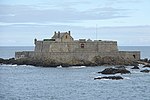Fort de la Conchée
1689 establishments in FranceBuildings and structures completed in 1689Buildings and structures in Ille-et-VilaineForts in FranceForts of Saint-Malo ... and 4 more
Monuments historiques of Ille-et-VilaineSaint-MaloSea fortsVauban fortifications in France
Fort de la Conchée is a fortification on the rocky island of Quincé, four kilometers north-west of St Malo, France. Constructed by Sebastien Vauban the fort covers almost the entire island. The fortress consists of a service building built on high, thick granite masonry walls two stories high. An oval upper terrace with embrasures facing the open sea served as the fort's site for the fort's battery. Today, the fort is a nature reserve for seabirds.
Excerpt from the Wikipedia article Fort de la Conchée (License: CC BY-SA 3.0, Authors).Fort de la Conchée
Passage des Bés,
Geographical coordinates (GPS) Address External links Nearby Places Show on map
Geographical coordinates (GPS)
| Latitude | Longitude |
|---|---|
| N 48.683611111111 ° | E -2.0441666666667 ° |
Address
Fort de la Conchée
Passage des Bés
35400
France
Open on Google Maps











